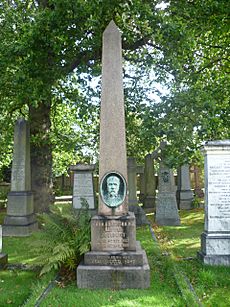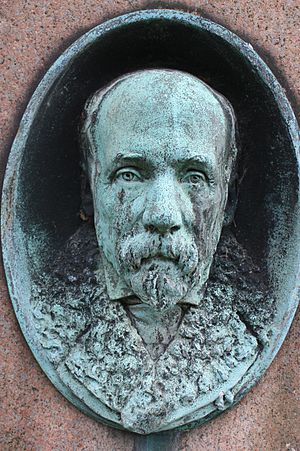John Anderson (zoologist) facts for kids
John Anderson (born October 4, 1833 – died August 15, 1900) was a Scottish scientist. He was an expert in anatomy (the study of body structures) and zoology (the study of animals). He is best known for his work in India, where he was the first curator of the Indian Museum in Calcutta (now Kolkata).
Contents
Early Life and Education
John Anderson was born in Edinburgh, Scotland. From a young age, he loved natural history, which is the study of living things. His brother, Thomas Anderson, also became a botanist (a plant scientist).
John first worked at the Bank of Scotland. But he soon left to follow his passion for science. He studied medicine at the University of Edinburgh. In 1861, he earned his degree. The next year, he received a special gold medal for his excellent work in zoology. He also helped start the Royal Physical Society of Edinburgh, a group for scientists. For two years, he taught natural history at a college in Edinburgh. During this time, he studied sea creatures found off the coast of Scotland.
Adventures in India

In 1864, John Anderson moved to India. He became the very first curator of the Indian Museum in Calcutta in 1865. A curator is someone who manages and cares for a museum's collections. He helped organize the museum's collections of mammals and ancient artifacts. He worked as curator until 1887. After that, he became the museum's superintendent, which is like a director.
Anderson was also an explorer. He went on several trips to China and Burma (now Myanmar) to collect animal specimens.
Exploring Burma and Yunnan
In 1867, he joined an expedition to Upper Burma and Yunnan, China. On this trip, he collected an Irrawaddy dolphin. He compared it to other dolphins, including the Ganges river dolphin. These studies helped scientists understand how different dolphin species are related.
He went on another expedition to the same area in 1875-1876. This trip was cut short due to an unfortunate event. In 1881-1882, he made a third trip for the Indian Museum. This time, he explored the Mergui archipelago in Burma.
Studying Animals and Cultures
John Anderson carefully studied the animals he collected. He compared their body structures, which is called comparative anatomy. He worked on reptiles, birds, and mammals. For example, he studied small mammals like the Hylomys shrew. He also wrote about the ethnology (the study of cultures) of the Selungs people from the Mergui islands. Many of the plant samples he collected are now kept in famous gardens and museums around the world.
In 1879, he became a Fellow of the Royal Society, a very important scientific honor. In 1885, the University of Edinburgh gave him an honorary law degree. While working at the Calcutta museum, he also taught comparative anatomy at the local medical school. In 1884, he and his wife, Grace, traveled to Japan. They collected many items from the Ainu people, an indigenous group in Japan. These valuable items were later given to the British Museum and the National Museum of Scotland.
Later Life and Legacy
John Anderson retired from his work in India in 1886. After returning to Britain, he continued his scientific work. He made many animal collections in Egypt. These collections became the basis for his book, Zoology of Egypt.
He passed away in Buxton, England, in 1900. He is buried with his wife, Grace, in Dean Cemetery in Edinburgh. A sculpture of his head marks their grave.
John Anderson's work greatly contributed to our understanding of animals, especially those from Asia. Many species have been named after him to honor his contributions to science. These include:
- Sacculina andersoni, a type of parasitic barnacle.
- Japalura andersoniana, a lizard.
- Opisthotropis andersonii, a snake.
- Trimeresurus andersonii, a venomous snake.



